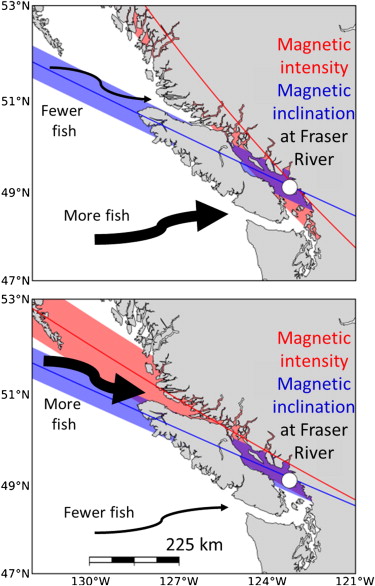We're open daily! View holiday hours
Science News
Salmon Sense of Direction
February 12, 2013

For those of you with a poor sense of direction, regard the sockeye salmon! (With envy!) These fish spend two to three years in the river near their birthplace, then travel close to 4,000 miles into the open ocean. Two to three years later, they return to the exact same spot where they hatched!
For years, researchers have suspected that the salmon use the Earth’s magnetic field to get back home, but scientists found little evidence to support this theory. Until now…
Researchers, reporting last week in Current Biology, took 56 years worth of data of salmon migration to and from the Fraser River in British Columbia. They then compared migration routes to the intensity of Earth's magnetic field at pivotal locations in the salmons’ migratory routes.
See, Earth has a magnetic field at its surface that weakens with proximity to the equator and distance from the poles and gradually changes on a yearly basis. Therefore, the intensity of the magnet field in any particular location is unique and differs slightly from year to year.
The trick for these Fraser River salmon is that to get to the open ocean and back they need to navigate around Vancouver Island. The sockeye can travel north via the Queen Charlotte Strait or from the south via the Juan de Fuca Strait.
The researchers discovered that the intensity of the magnetic field largely predicted which route the salmon used to detour around Vancouver Island; in any given year, the salmon were more likely to take whichever route had a magnetic signature that most closely matched that of the Fraser River years before, when the salmon initially swam from the river into the Pacific Ocean. (See image, above right.)
“These results are consistent with the idea that juvenile salmon imprint on (i.e. learn and remember) the magnetic signature of their home river, and then seek that same magnetic signature during their spawning migration,” says Nathan Putman, a post-doctoral researcher at Oregon State University and the lead author of the study.
Other factors, in addition to Earth’s magnetism, also influence the route, Putman says. Once the salmon reach their home river, they probably use their sense of smell to find the particular tributary in which they were born.
Because salmon populations are so important to Northwest economies, the authors hope this study will aid in forecasting fish movement for better fisheries management and conservation.
Image courtesy of Nathan F. Putman et al.